BIRDS AS ART BULLETIN 246
Visit www.birdsasart.com
PORTLAND, MAINE: “The Art of Nature Photography; It Ain’t Just Birds Seminar”
OLD DOG/NEW TRICKS: TANDAYAPA ECUADOR TRIP REPORT
ABP II KUDOS
BEAR BOAT OPENINGS
40D (AND MARK III) SENSOR CLEANING ISSUES ALONG WITH SENSOR SCOPE COMMENTS
THANKSGIVING LUNCH
ROBERT AMORUSO MERRITT ISLAND NWR WORKSHOP
GEAR FOR SALE
IPT UPDATES
Contact us by phone at 863-692-0906 (Eastern Time Zone) or by e-mail at birdsasart@att.net or @verizon.net. The att e-mail address is best from overseas.
We gladly accept credit card orders by phone 8am till
You can use the PayPal links on the web site to order anything. Just type in the item(s) and the amount. If using your own PayPal account, please send to either of the e-mail addresses above.
Note: maximize this e-mail for best formatting.
Photographic theme: my favorite images from my recent trip to Ecuador.
Important Request: if responding to this e-mail, please take the time to delete all images and all irrelevant text.
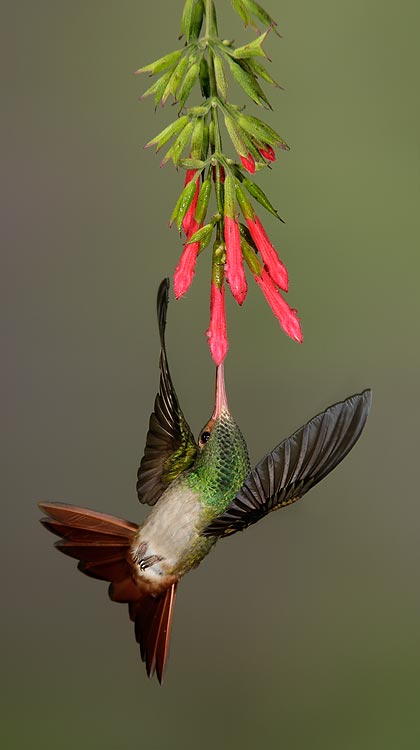
Rufous-tailed Hummingbird at flowers, Tandayapa Bird Lodge, Ecuador
Image Copyright 2007: Arthur Morris/BIRDS AS ART
Canon 500mm IS lens with the EOS-1D MIII. ISO 400. Manual mode: 1/300 sec. at f/16. Four flash set-up.
Do
understand that with this type of
photography there is a lot of luck involved. For the
most part, you have zero control over the position of the wings, or even the
placement of the bird in the frame. Why? They are so damned fast.
Get them in the frame, press the shutter button, and see what you get. The
hard part is creating the set-up and getting all the flashes right.
PORTLAND, MAINE: “The Art of Nature Photography; It Ain’t Just Birds” Weekend How-To Seminar
“The Art of Nature Photography; It Ain’t Just Birds” Weekend How-To Seminar in Portland, Maine
October 11-12, 2008
Eastland Park Hotel, 157 High Street, Portland, ME
The October 11-12 date was carefully chosen to coincide roughly with the average peak of fall color in southern Maine. The likelihood is that if you are coming from out of town and would like to photograph the fall color the best bet (taking global warming and the trends in recent years) would be to schedule your photography in the days following the seminar. Every year, however, is different, and this is nature photography so there are no guarantees, but chances are, whether you photograph just before or just after the seminar you should have many chances to create some great images. Best bet: come a few days early and stay on for a few days… (Hint: hope for a pre-dawn rainstorm followed by the sun breaking through in the east while grayish-black storm clouds fill the western sky…)
The seminar will be held at the Eastland Park Hotel. Folks staying at least two nights in the hotel will receive a free Lens Pen Combo Kit at the seminar. As fall color time is peak season in southern Maine, hotel rates are high anywhere in the region. We were able to negotiate a rate of $159 for folks registering early. Once the block of rooms is gone, higher rates will apply. The doors will open on both days at 8 am and the programs will begin at 9 am sharp. There will be tons of great door prizes (including Delkin e-film Pro compact flash cards and some great stuff from Lowepro and Wimberley). I hope that you will be able to join me for what will be an incredibly educational and fun-filled weekend. (If anyone would like to help us set up or to hang out, be there at 7:00am.)
This seminar is for all nature photographers who want to learn how to make better photographs. On Saturday I will describe the methods and techniques that I have developed and used since 1983. My comments on equipment (including and especially digital equipment), autofocus, light, and on composition and image design, and my tips on getting close to free and wild subjects and creating pleasing blurs will benefit everyone with a telephoto lens who wishes to dramatically improve the quality of their images. Since going all-digital in November 2002, I have--in short order--become a digital photography and Photoshop expert. My approach to optimizing images is to create a master file of excellent quality in the shortest possible time. I will share our workflow and numerous Digital and Photoshop tips on Sunday. As more and more folks are using Digital Capture, I am finding on our IPTs that many good to excellent photographers have no clue as to how to use Photoshop to make their images look better. In fact, many of them make their best images look worse! My workflow is designed to quickly produce master files of high quality. I can and will teach you to do just that at this seminar.
The cost of the weekend seminar will be $169. The cost of either single day will be $99. Members of qualifying camera clubs are invited to apply a $10 discount. (If you are a member of a camera club or other photography organization please e-mail us before registering to learn how your group can become a qualifying club). Register with a friend or a spouse and take $10 off each registration. Register in groups of four or more and take $20 off of each registration. Register in a group of ten or more and take $30 off each registration. It is highly recommend that folks purchase the buffet luncheon option ($15/day includes tip and tax). Those purchasing the lunch option will receive their lunch coupon when they check in each morning.) The cost of the weekend seminar plus the two lunches is $199.
To register, send a check for the full amount made out to "Arthur Morris" to PO Box 7245, Indian Lake Estates, FL 33855, call with a credit card: 863-692-0906, or send a Paypal (using either any link on our site or your Paypal account) to us at birdsasart@att.net In all cases, we will need your e-mail address, your mailing address, and your daytime and evening phone numbers. Here is our Cancellation Policy: If for any reason you need to withdraw, please notify us ASAP. Once we receive your e-mail, phone call, or written notice of your cancellation the following fees apply: cancel before July 10, 2008 and your fee will be refunded less a $20.00 cancellation fee; cancel by August 10, 2008 and your fee will be refunded less a $50.00 cancellation fee; cancel after September 10, 2008 and there will be no refund.
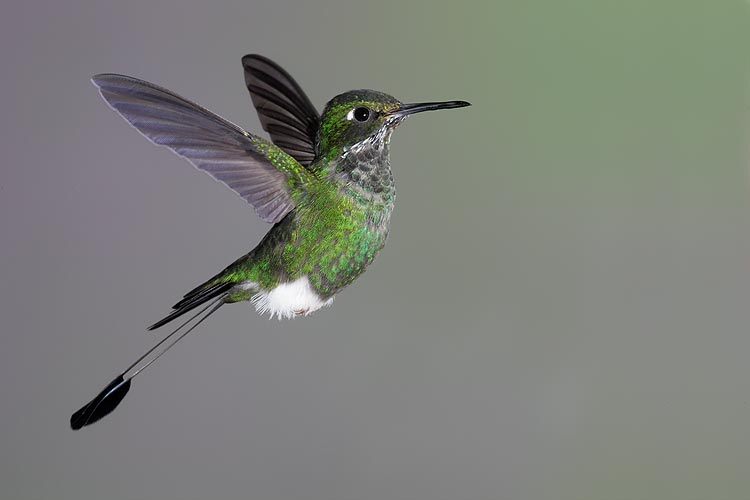
Booted Racket-tail, male, Tandayapa Bird Lodge, Ecuador
Image Copyright 2007: Arthur Morris/BIRDS AS ART
Canon 500mm IS lens with 25mm extension tube and the EOS-1D MIII. ISO 400. Manual mode: 1/300 sec. at f/22. Five flash set-up.
These guys fought often as they hung vertically with their tails spread. I tried to get something really good on the fights but that image will have to wait till next time. I love the wings full up position here. Note also the perfect head angle.
OLD DOG/NEW TRICKS: TANDAYAPA ECUADOR TRIP REPORT
In mid-October, I flew to Quito, Ecuador for a busman’s holiday, photographing hummingbirds in flight with multiple flashes. An old friend and student loaned me all of the gear—a ton of stuff is needed—and gave me the basic instructions that I needed to get started. I have visited Tandayapa Bird Lodge several times, and knew that it would be the perfect place to try and learn a completely new technique. For three days, I had problems with ghosting but I knew that it was not from the ambient light as I was many stops below the correct ambient exposure. I struggled and struggled, finally calling old friend, student, and one-time employee Ralph Paonessa. I reached him at his home office in California from a “cabina” (internet phone service store) in the tiny town of Nanegalito. Though the rate was only 6 cents a minute I ran up a $10 phone bill. Ralph suggested that one of the flashes was bad and subsequent testing proved him correct. One of the flashes was putting out more flash than I had dialed in. The effective shutter speed is determined by the duration of the flashes; each flash is set to Manual mode. If all of the flashes are set to the same output, but one flash is putting out more light than you have dialed in, then the effective shutter speed of that flash will be slower than the effective shutter speed of the other flashes. The good flashes all fire and make a sharp exposure, but the bad flash stays on longer and creates a ghosted image if the hummingbird’s wings are moving quickly (which they usually are…) Once that problem was solved, creating sharp images was a snap. I also spent almost a full day at a restaurant in Los Bancos, about an hour from Tandayapa by car; there were some great tanagers, aricaris, and toucanets there as well as some different hummers.
I had a ton of fun fine-tuning the flash set-ups and came up with many new techniques. I worked so hard at this and learned so much that in several months we will be offering a Guide to High Speed Flash Hummingbird Photography. The HSFH Guide will be written in our legendary style: easy to read and easy to understand text along with easy to follow instructions. The guide will be lavishly illustrated and include problem images to make your troubleshooting easier. I am hoping that this guide will be available sometime in late December.
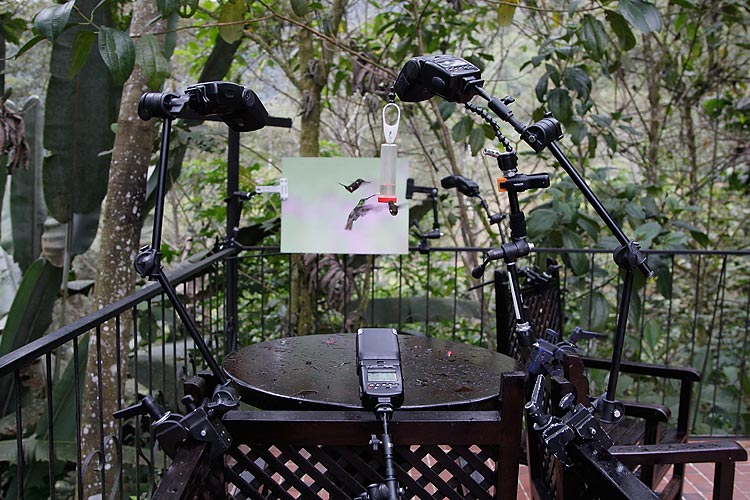
Four flash high speed set-up, Tandayapa Bird Lodge, Ecuador
Image Copyright 2007: Arthur Morris/BIRDS AS ART
Before you decide to order our guide and get started in high speed flash hummingbird photography consider the cost of all the gear and the problems of getting it to the hummingbird site… Can you say “big time hassle”?
ABP II KUDOS
I received the following via e-mail from Bob Blanchard:
Artie, I just wanted to send a quick e-mail and let you know how much I am enjoying your The Art of Bird Photography II CD! I'm only about 175 pages into it on my first read through, but I'm already seeing the enormous value in this book. This one will be re-read many times over I'm sure. A little about me: I've been a photographer for over 30 years (amateur, with moderate sales and published works). It's a passion for me, but a part-time one. I'm a Systems Engineer by trade. I got my first 35mm when I was 13 years old. It was a Kodak Retina Reflex III; I still have it. All manual, but you DEFINITELY learn photography with a camera like that. I used that camera for 7 or 8 years until I could afford my first "dream" camera: A Canon A-1 in 1983. I then graduated to the F-1 Canons, but never bothered with the EOS line of film cameras. That said, I was one of the last film "hold-outs". In mid-2006, I made the decision to go Digital. I had never even owned an auto-focus body before that! I went from the Canon FD series to a 1DsMII! To say the least, that's a big jump.
While the operational learning curve is pretty vertical, the fundamentals remain the same. At the end of the day, it's all about visualization, composition, light, DOF, and speed to mold the shot into the desired outcome (although Photoshop plays a role now too, I still prefer to get it mostly right from the camera). I also switched genre when I went digital. I had never been a wildlife photographer until moving to Florida. I mostly shot landscape, urban, and special effects/night stuff. To say the least, I'm hooked on birds (but I do some macro work as well). I am, however, a "newbie" in the wildlife genre.
Anyway, I explain this because I wanted you to know WHY I love what I've read so far. You explain the images so well that I can "see" the light as you explain things. Most photographers that I have encountered in my quest for knowledge in the digital world never shot a manual camera. Their camera did all their thinking for them, and they consequently do not understand light, let alone how to manipulate it photographically (or explain it to an inquiring newbie)! They post their EXIF, and leave out the important variables of the shooting conditions (time of day, weather, direction of light source, reflective influences, distance from subject, etc.)! In short, I really don't gain much from reading their posts because they lack detail; typically, they get angry when I ask for more detail (as if I'm challenging their choice of settings).
When I compose a shot, I see it in my mind’s eye first. I then study my light, and set my camera to create the image that I have in mind. From my manual days, I developed an ability to very quickly process the shot mentally, and pretty much knew what my settings would be within reason (I'd bracket when I wasn't 100 percent sure). Even with my F-1 bodies, I used manual mode most of the time. Nowadays I use Aperture Priority most of the time but I still use manual mode on occasion, especially when shooting macro. I sure love the ability to manipulate ISO on the fly to accommodate desired DOF settings.
Anyway, my point is that you not only CLEARLY know the light, but you have the rare gift of being able to explain it! I am convinced that I could probably learn TONS by simply looking at your images, reading the EXIF data, and then reading YOUR explanation of the image! You explain the WHY! Most others don't even know what the "WHY" is. I love it. Your images are incredible, but equally incredible is your ability to explain them. I get it! This CD is going to save me a TON of self-learning! Until now, I was limited to my own self-learning and experimentation. While that is still an important part of the process, ABP II will quickly move me MUCH further and faster into the direction I want to go.
Thank you! Bob Blanchard
You can learn more about my CD book, “The Art of Bird Photography II”, here: http://www.birdsasart.com/ABPII.htm. And a big time thanks to Bob for his kind words and for taking the time to write.
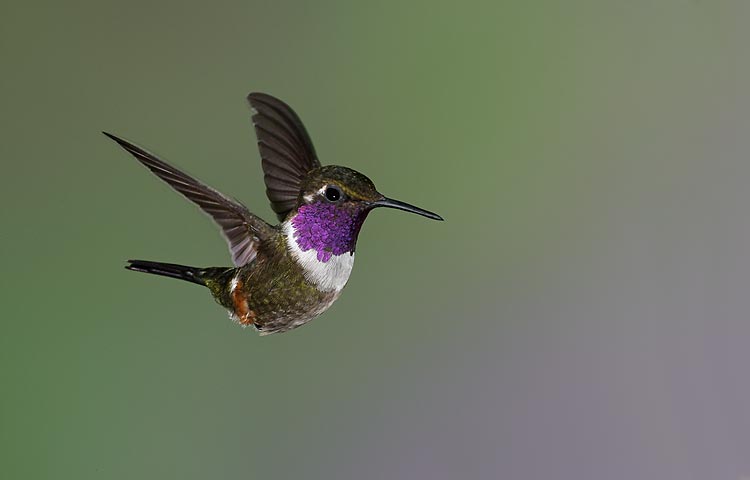
Purple-throated Woodstar, male, Tandayapa Bird Lodge, Ecuador
Image Copyright 2007: Arthur Morris/BIRDS AS ART
Canon 500mm IS lens with 12mm and 25mm extension tubes and the EOS-1D MIII. ISO 400. Manual mode: 1/300 sec. at f/22. Five flash set-up.
This species was so tiny that I used the two extension tube and moved a yard closer. As I was closer, I needed to check the exposure via histogram. Our guide will teach you how to quickly and easily determine the best exposure for both middle-toned species and for species with a significant amount of white feathering.
BEAR BOAT OPENINGS
Due to a cancellation, there is room for a male single on Robert O’Toole’s BAA Bear Boat trip:
Bear Boat Trip #1: June 4-10, 2008. $5999. Led by Robert O’Toole plus professional bear guide. (Limit: 6 photographers, openings: 1.) You must be in Anchorage no later than the afternoon of June 3, but June 2 is recommended. Bears, bears, and more bears including cubs, bears clamming, bears in the meadows, baby Bald Eagles in the nest, Black-legged Kittiwake rookeries, and loads of Sea Otters.
Please e-mail for additional details or contact us via e-mail at birdsasart@att.net if you are seriously interested. Bear Boat Trip #2 in September 2008 is full with a waiting list.

Pale-mandibled Aricari, Los Bancos, Ecuador
Image Copyright 2007: Arthur Morris/BIRDS AS ART
Canon 500mm IS lens with the EOS-1D MIII. ISO 800. Evaluative metering +1/2 stop: 1/160 sec. at f/8. Fill flash at -1 2/3 stops with Better Beamer.
I about fainted when this guy came in for a banana lunch. I quickly removed my 1.4X TC and backed up. If I added any more light the whitish-yellow tones of the bill were overexposed. Tip: no matter how exciting the situation, it pays to take a second to check for flashing highlights… In most cases I am so sure of the correct exposure compensation that I may opt to skip that step…
40D (AND MARK III) SENSOR CLEANING ISSUES ALONG WITH SENSOR SCOPE COMMENTS
Last week I received this e-mail from Shaun:
Hi Folks, I purchased a few Lens Pen Combo Kits from you a while back, and I have been very pleased with the way they have enabled me to maintain my 20D’s, then 30D’s... Thank you! I’ve even suggested them to several of my students and pro friends... I have recently purchased a 40D however, and I’m reluctant to try to clean the sensor until I get the go ahead from you guys, or from someone else who has tested this particular combo... In spite of the new “shaker” sensor cleaning technology dust on my 40D is beginning to build up... Please let me know what you think... Cheers, Shaun
Here are my thoughts:
Folks should not have any problems cleaning the sensors of cameras with anti-dust features. My three Canon EOS 1D MIII camera bodies have the EOS Integrated Cleaning System. The sensor is cleaned automatically whenever the camera is turned off. The system works so well that in Africa—where it is dustier than the inside of a vacuum cleaner—I had to use my Lens Pen on the sensor of my workhorse body only once. And I did so successfully using the Sensor Scope to check for dust and then to inspect my work quickly, easily, and efficiently.
At Tandayapa, I had two specks of dust that could not be removed by my camera’s Integrated Cleaning System so I used my Sensor Scope and the small Lens Pen to make things perfect. When you are working at f/22, it is imperative that your sensor be absolutely clean. As much as I love my Sensor Scope and would never consider traveling without it, there are some limitations and in Ecuador I did learn an important lesson. I checked the sensor of another photographer’s MII 1Dn at Tandayapa with the Sensor Scope and it looked pretty good. There was only one speck of dust visible; I removed it easily with the Lens Pen and checked the sensor with the Sensor Scope. Everything looked fine. But the images made after I cleaned the sensor showed a mess of smudgy dust in one corner, smudgy dust that I did not see with the Sensor Scope. It was only evident in image made at tiny apertures like f/22. Once we made that discovery I cleaned the entire sensor with the Lens Pen using the exact techniques described in the file that we send folks who purchase Lens Pen Combo Kits from us. When I was done we created a test image by photographing the sky at f/32; this time the sensor was spotlessly clean.
I would suggest that folks who will be working at apertures of f/16 or smaller create a test image by photographing a blue or white sky at f/32 before beginning their work and then cleaning the sensor as needed.
To learn more about the Lens Pen Combo Kit, our Micro-Fiber Cloth, and the Giotto Rocket Blower, click here: http://www.birdsasart.com/lenspens.htm
We have lowered the price of Sensor Scopes as follows:
You can order a SensorScope today for only $79.98 plus $7.00 shipping and handling in the US. The total is $86.98. Florida residents please add 7% sales tax to the cost of the item only: ($92.58 total). Overseas customers please e-mail your complete ship-to address to receive a shipping quote. Paypal is quite convenient. You can call us at 863-692-0906 with credit card in hand, or send a check for the correct amount made out to “Arthur Morris” to us as follows: Arthur Morris/BIRDS AS ART, PO Box 7245, 4041 Granada Drive, Indian Lake Estates, FL 33855.
You can learn more about the Sensor Scope here: http://www.birdsasart.com/delkin.htm#Sensor%20Scope
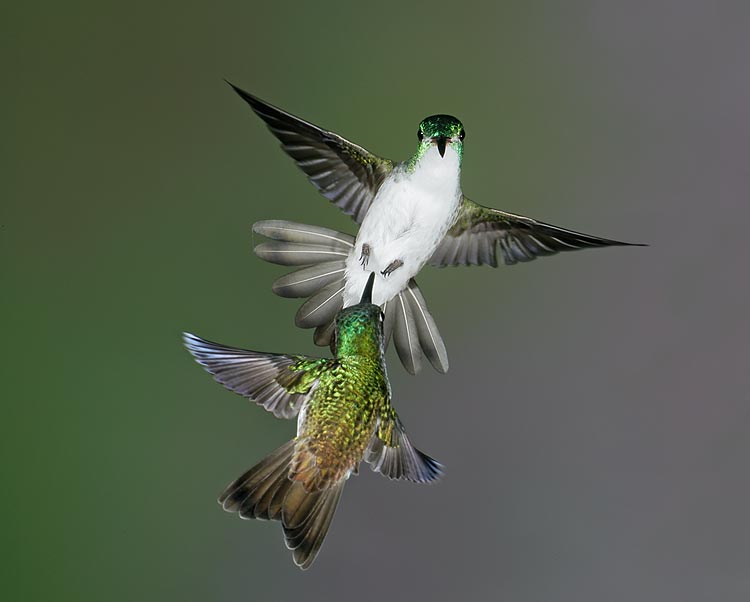
Andean Emeralds squabbling, Tandayapa Bird Lodge, Ecuador
Image Copyright 2007: Arthur Morris/BIRDS AS ART
Canon 500mm IS lens with 25mm extension tube and the EOS-1D MIII. ISO 400. Manual mode: 1/300 sec. at f/25. Five flash set-up.
If you are thinking how skilled I am as to be able to capture two hummers fighting, please dismiss those thoughts. I was trying to get the bird in the back in focus and in-the-frame and got the forward combatant as an unexpected bonus! I got in the habit of cutting the exposure 2/3 stop when they came on the scene to avoid burning their very white breasts. I selectively sharpened the bird in the front using the contrast mask trick as described in Digital Basics: Digital Basics: http://www.birdsasart.com/digitalbasics.htm.
THANKSGIVING LUNCH
On Thanksgiving Day, Thursday, November 22, 2007, I will once again be hosting a lunch for visiting photographers and birders. We can accommodate 50 folks; forty-four slots have already been spoken for; this event will be sold out soon so do not hesitate to register. For the third consecutive year, the lunch will be held at the Luna Mansion, an historic building in Las Lunas, New Mexico that is about an hour up the pike from Socorro on I-25. And oh, the food is superb. You can learn more about Luna Mansion here: http://thelunamansion.com/. The cost of the complete lunch will be $35. This will include several courses including your main course, a dessert, a non-alcoholic beverage, and the tip. If you have wine or a cocktail with your meal you will need to pick up the tab for that. All reservations must be paid for in advance by check only—no Paypal or credit cards. If you would like to join us please let us know by e-mail that you will be sending a check (made out to “Arthur Morris”) ASAP to us here: PO Box 7245, Indian Lake Estates, FL 33855.
If you will be joining us, please plan on being at the Luna Mansion no later than 11am sharp. I do hope that you can make it.
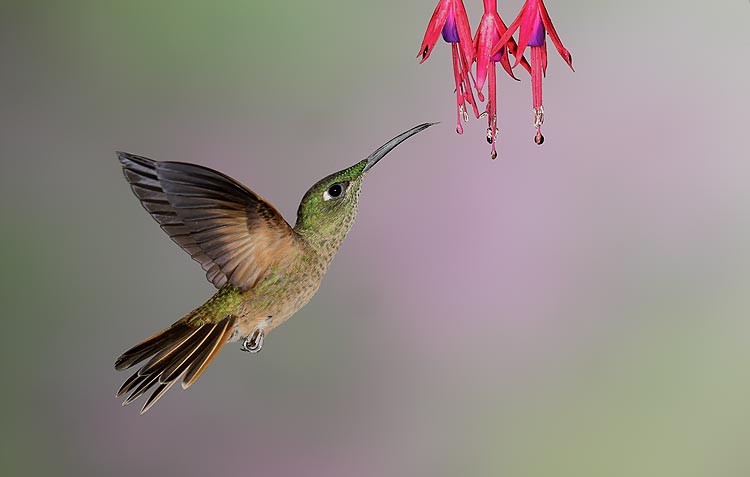
Fawn-breasted Brilliant at flowers, Tandayapa Bird Lodge, Ecuador
Image Copyright 2007: Arthur Morris/BIRDS AS ART
Canon 500mm IS lens with EOS 1D MIII. ISO 400. Manual mode: 1/300 sec. at f/16. Five flash set-up.
We laced the blossoms with sugar water to get the birds to come onto the set. The flowers were held in place with a Wimberley Plamp.
ROBERT AMORUSO MERRITT ISLAND NWR WORKSHOP
Merritt Island NWR/Viera Wetlands/Canaveral National Seashore Photographic Instructional Workshop. 3-DAYs: January 11-13, 2008. Cost per person: One Day $300, Two Days $550, Three Days $800. Sign up for one, two or all three days. Hotel, meal and travel costs are not included. A 50% non-refundable deposit is required to reserve a spot with the remainder due by December 11, 2007.
Includes morning and afternoon in-the-field photography sessions and evening instructional sessions at some of the most diverse wildlife and avian photography locations in Central Florida. Attendance includes a free copy of Robert’s BAA MINWR Area Site Guide.
You can download the full details here: http://www.wildscapeimages.biz/2008_MINWR-Area_Workshop.pdf
Learn more about Robert here: www.wildscapeimages.biz
You can contact Robert at 407-808-7417 (cell phone) or info@wildscapeimages.com for information on the above.
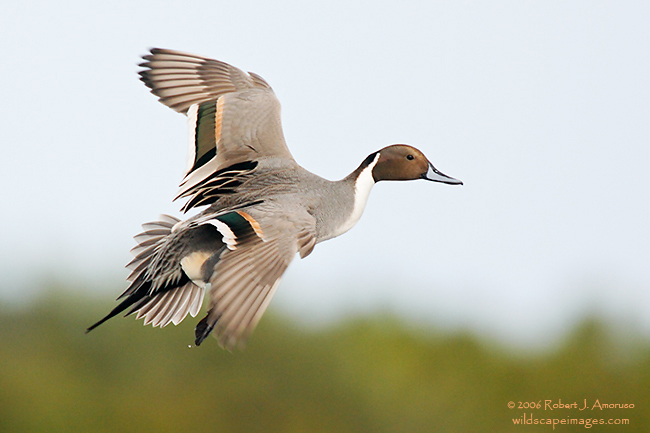
Northern Pintail, Merritt Island NWR, Titusville, FL
Image Copyright 2007: Robert Amoruso/Wildscape Images
GEAR FOR SALE
Note: Be a good consumer. It is the purchaser's responsibility to ensure that the goods received are as described...
Patrick Ford has a like-new Canon EOS 1D Mark lll camera body for sale. Original box with everything inside included. Only 600 actuations with original warranty card. Asking $3900. Contact Pat by e-mail at tpfordjr@bellsouth.net or on his cell phone at 1-305-323-9943.
Simon DuPlooy is offering a Canon EOS-1Dn Mark ll in mint condition for sale for $2,000 plus shipping. Everything (wires, cables, chargers, CDs, manuals, etc) but the original box is included. You can e-mail Simon at simon@simondp.com or at duplooy@shaw.ca or by phone as follows: home: 403-347-4652 or mobile: 403-392-5790.
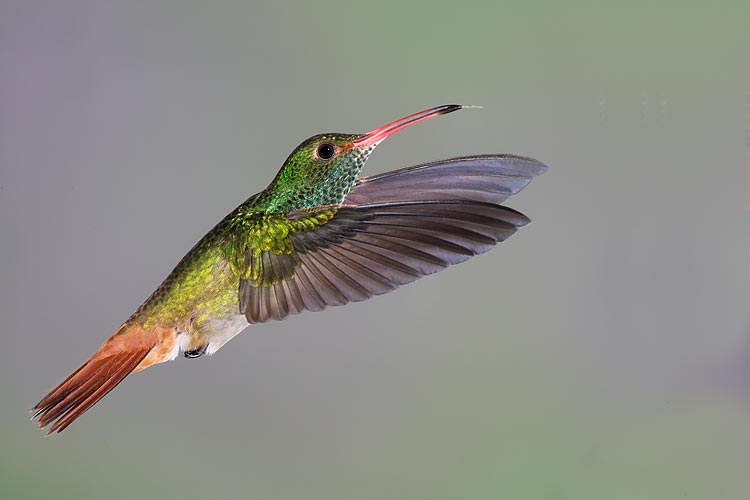
Rufous-tailed Hummingbird, Tandayapa Bird Lodge, Ecuador
Image Copyright 2007: Arthur Morris/BIRDS AS ART
Canon 500mm IS lens with a 25mm extension tube and the EOS-1D MIII. ISO 400. Manual mode: 1/300 sec. at f/22. Five flash set-up.
This species being relatively slow-moving (the key word being relatively…) was the easiest to photograph at Tandayapa. Here I love both the sharpness and the wings forward pose.
IPT UPDATES
Bosque #1: "The Fall Color IPT" NOV 13-15, 2007. Slide Program on the evening of NOV 12. 3-DAY: $999. (Limit 14; Sold Out). Co-leader: Robert O'Toole. Guest leader (DAY 3 only): Andy Rouse. This IPT should feature a better chance for a day or two of the rare south winds that drastically improve flight photography and will definitely feature the brightest fall-color cottonwoods.
Bosque #2: "The Pre-Thanksgiving IPT" NOV 18-20, 2007. Slide Program on the evening of NOV 17. 3-DAY: $999. (Limit 14; Sold Out). Co-leader: Robert O'Toole, Robert Amoruso, & Alfred Forns. Guest leader: Andy Rouse. This IPT will feature increasing numbers of geese and cranes with lots of great opportunities.
Bosque #3: "The Post-Thanksgiving IPT" NOV 24-26, 2007. Slide Program on the evening of NOV 23. 3-DAY: $999. (Limit 14: Sold Out). Co-leaders: Robert O'Toole, Robert Amoruso, and Alfred Forns. This IPT is scheduled on dates that I consider peak for Bosque. (There may be a Full Moon Add-on NOV 23; details TBA.) If you register for this one, hold off on buying your plane ticket if you might be interested in the add-on.)
SW FLA Post X-mas IPT: DEC 27-29, 2007. Slide program on the of evening Wednesday, DEC 26, 2006. 3-DAY: $1029. (Limit 12; Sold Out). Co-leaders: Alfred Forns, Robert O'Toole, & Robert Amoruso. Joining us as guest co-leader will be full time professional photographer John Moran, Florida's unofficial Photographer Laureate. You can learn about John’s amazing work here: www.johnmoranphoto.com. John will be doing his program, “Journal of Light: A Photographer's Search for the Soul of Florida" for the group on Wednesday, DEC 26 at 3:30 pm. John’s work is so different from mine and from everyone else’s that he has been a huge inspiration to me over the past two years. We will be visiting Sanibel Island, Venice Rookery, Cape Coral, and possibly Little Estero Lagoon (depending on the tides). Herons, egrets, gulls, terns, skimmers, shorebirds, both pelicans, Osprey, Burrowing Owl, and lots more. Roseate Spoonbill and Wood Stork possible.
San Diego IPT: Jan 20-23, 2008. Slide program on the Saturday early evening of JAN 19. 4-DAYS: $1399. (Limit 12: Sold Out) LaJolla, LaJolla Shores Beach, Coronado, and Santee Lakes. Brown Pelicans in spectacular breeding plumage, Heerman’s & Western Gulls, Marbled Godwits & lots more shorebirds, Wood & Ring-necked Ducks & Lesser Scaup. Great flight photography. And lots more.
SW FLA President's Holiday IPT: MAR 17-21, 2008 5-DAY: $1669. (Limit 14; openings: 6). Slide program on the evening Sunday, MAR 16, 2007. Co-leaders: Robert O’Toole, Alfred Forns, Fabiola Del Alcazar, & Robert Amoruso. Sanibel Island, Little Estero Lagoon, Venice Rookery, Cape Coral. Herons, egrets, gulls, terns, skimmers, shorebirds, both pelicans, Osprey, Burrowing Owl, and lots more.
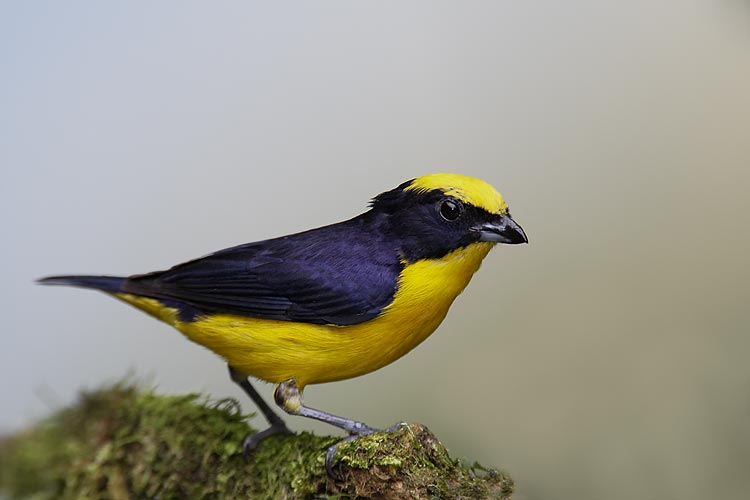
Thick-billed Euphonia, Los Bancos, Ecuador
Image Copyright 2007: Arthur Morris/BIRDS AS ART
Canon 500mm IS lens with the 1.4X II TC and the EOS-1D MIII. ISO 800. Evaluative metering at +11/3 stop: 1/400 sec. at f/6.3. Fill flash at -1 1/3 stop with Better Beamer.
I used Robert O’Toole’s Quick Masking Techniques to remove a big, squishy banana from the right side of the frame and then cleaned up the edges with the Patch Tool and the Clone Stamp. You can learn more about Robert’s APTATS PDF here: http://www.birdsasart.com/aptats.htm
The converted RAW file is below:
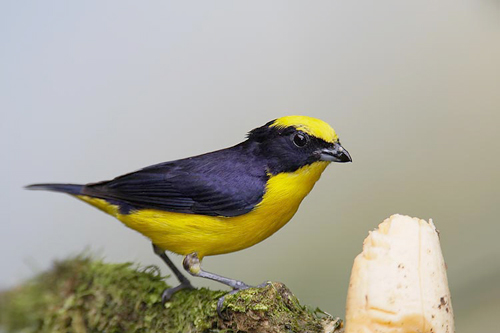
Best and love and great picture-
artie
Note: Arthur Morris has been a Canon contract photographer since 1996
and continues in that role today. Hunt's Photo of Boston, MA is a BAA sponsor
as is Delkin
Devices. Back issues of all BAA Bulletins can be found in the Bulletin
Archives which